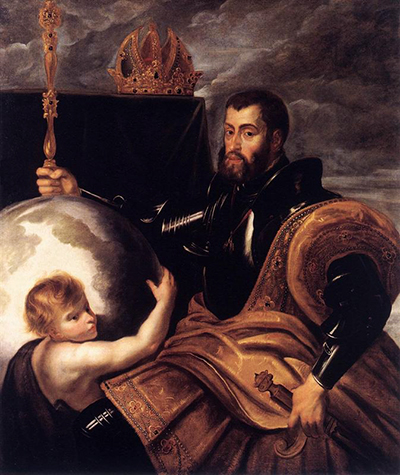In 1604, the German artist Peter Paul Rubens created this oil-on-canvas painting of the Emperor Charles. He had just been on a diplomatic mission to Spain.
In the portrait, Emperor Charles appears dressed for battle, wearing armour. His imperial crown is seen on a shelf nearby. He holds his sceptre in his right hand and his sword in his left. The impression one gets of the Emperor is that of a man of action. A man who embraces the battlefield as part of his responsibility to rule.
We are shown the Emperor as a dutiful man who does not shirk from what needs to be done. Even though we are beholding a man who is completely at home with all the trappings of an emperor, the man also appears to be delightfully sensitive and human. We can see the humanity of the person even though the trappings of power are present. The colour scheme of this painting is gold, black and grey.
This style of painting is known as the Baroque style. This portrait differs from the religious and mythological scenes which this prolific artist usually produced. Rubins was a most prolific artist. This is a style that flourished in western Europe in the early 17th century.
Baroque painting is noted for its high drama, rich colours, strong light and dark shadows. Peter Paul Rubins is considered to be the greatest and most influential of all the Baroque artists. He is also well-known for his voluptuous celebration of the female form and the adjective 'Rubenesque' when describing a voluptuous female subject is attributed directly to his artistic betrayal of the female form.
About the Artist
A true Renaissance man, Peter Paul Rubens lead a balanced life. He was as famous for his diplomacy as he was for his paintings. He associated with many of the leading people of his time. As an artist, he got to mix with royalty and the nobility and it was the same for his diplomatic career. He also met many influential people who inspired his painting. Although a creative man, he was truly disciplined. He rose early in the morning. After completing his day's work, he would go riding to maintain his fitness level. Indeed, when his beloved wife Isabella, died after a long marriage, he attracted another young wife and went on to have another family. Such was the charm and youthfulness of the man.




